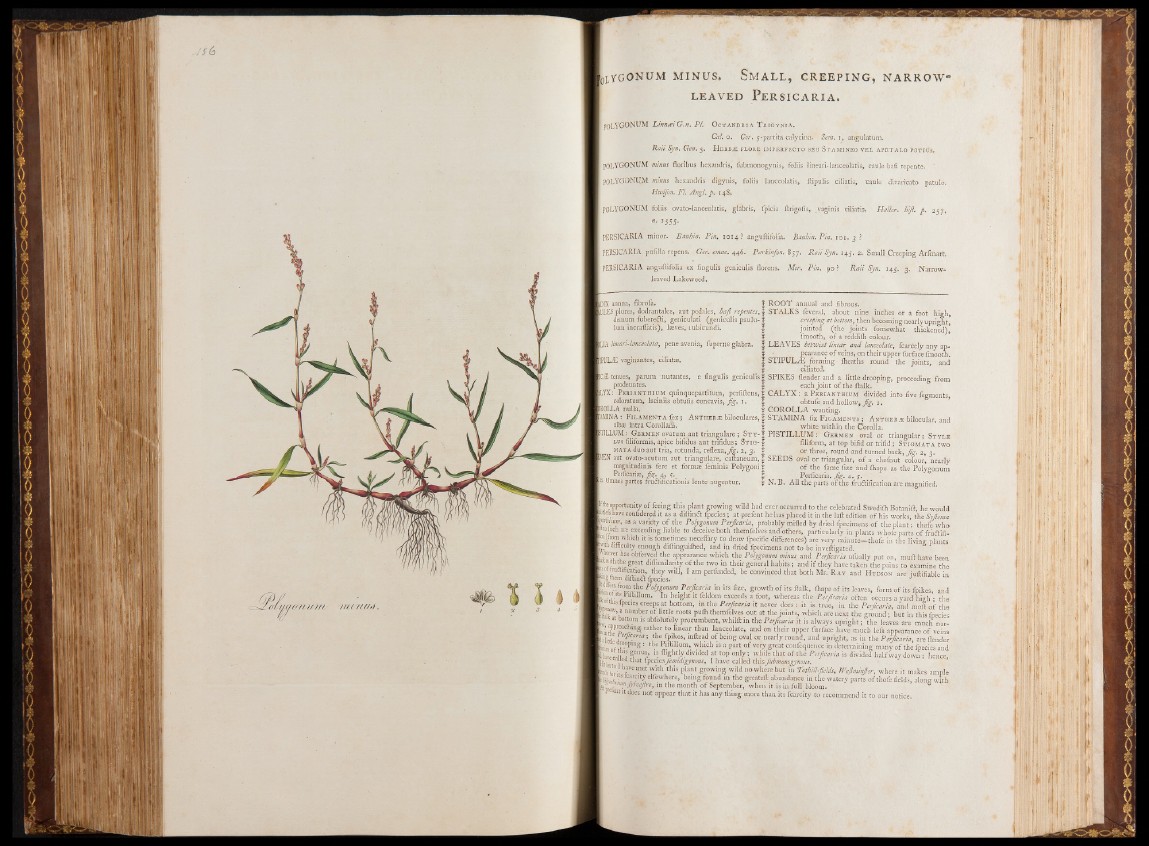
j^GONUM minus, small, creeping, narrowleaved
Persicaria.
IPOLYGONUM LinnaiGiti. PI. Octandria T rigynia.
Cal. o. Cof. 5-partita calycina. S'em. r, angulaturtt.
Rail Syn. Gen. 5. Herb.® flore imperfecto seu Stamineo veL apEtalo potiüs.
I POLYGONUM minus floribus hexandris, fubmonogynis, foliis 1 ineari-lanceoläti$-, caule bafi repentev '
■ POLYGONUM minus hexaudris digynis, foliis lanceolatis, ftipulis ciliatis, caule divaricatö patulö-,
Hudfon. Fl. Angl. p-. 1481
I POLYGONUM foliis ovato-lanceolatis, glabris, fpicis ftrigofis, vaginis ciliatis-. Haller, hiß. p. 257.
I r555*
I PERSICARIA minor. Bauhin. Pin. 1014 ? anguftifolia. Bauhin. Pin. 101. 3 ?
I PERSICARIA pufilla repens. Ger- emac. 446. Parkinfon. 857. Rail Syn. 145. 2-. Small Creeping Arfmart.
I PERSICARIA anguftifolia ex fingulis geniculis florensv Mer. Pin. po! Raii Syn. 145, 3. Narrowleaved
Lake weed.
pX annua, fibrofa. |
lüLES plures, dodrantales, aut pedales, bafi repentes, |
demum fubere&i, geniculati (geniculis paulu- f
luna incraflatis), lasves, rubicundi. | j I LIA lineari-lanceolata, pene avenia, fuperne glabra. |1
BPULÆ vaginantes, ciliatæ.
|1C Æ tenues, parum nutantes, e fingulis geniculis |i
prodeuntès. |
^LYX: Perianthium quinquepartitum, perfiftens, J
coloratum, laciniis obtufis concavis, fig. 1. |
jROLLA nulla.
{AMINA: F il am e n t a fex ; A ntheræ biloculares, |
albæ intra Corollam. sp
|TILLUM : Germen ovatum aut triangulare ; St y - |
lus filiformis, apice bifidus aut trifidus; Stig- |
mata duo aut tria, rotunda, reflexa,^. 2, 3. ?
jMEN aut ovato-acutum aut triangulare, caftaneum, |
magnitudinis fere et formæ lèminis Polygon; ?
Perfictfriæ, fig. 4, 5. _ |
|B. Omnes partes fruâificationis lente augentur. f
ROOT annual and fibrous.
STALKS feveral, about nine inches of a foot high,
creeping at bottom, then becoming nearly upright,
; jointed (the joints fomewhat thickened),
fmooth, of a reddifh colour.
LEAVES betwixt linear and lanceolate, fcarcely any appearance
of veins* on their upper furface fmooth.
STIPULAE forming {heaths round the joints, and
ciliated.
SPIKES {lender and a little drooping, proceeding from
each joint of the ftalk.
CALYX : a Perianthium divided into five fegments,
obtufe and hollow* fig. 1.
COROLLA wanting.
STAMINA fix F ilaments ; A nther® bilocular, and
white within the Corolla.
PISTILLUM: Germen oval of triangulaf; Style
filiform, at top bifid or trifid; Stigmata two
or three, round and turned back, fig. 2, 3.
SEEDS oval or triangular, of a chefnut colour, nearly
of the fame fize and fhape as the Polygonum
Perficaria, fig. 4, 5.
N.B. All the parts of the fructification are magnified.
| At opportunity of feeing this plant growing wild had ever occurred to the celebrated Swedilh Botanift, he would
pltls have confidered it as a dittinft fpecies ; at prefent he has placed it in the laft edition of his works, theSyftema
a! a variety of the Polygonum Perficaria, probably milled by dried fpecimens of the plant: thofe who
Jttoiuch are exceeding liable to deceive both themfelves and others, particularly in plants whofe parts of friaifi-
l l g H f f l 111S necefiary to draw fpecific differences) are very minute— thofe in the livino- plants
5 “ aimculty enough diftinguilhed, and in dried fpecimens not to be inveffigated. °
pVnoever has obferved the appearance which the Polygonum minus and Perficaria ufUally put on, muff have been
I S ™ P « diffimilarity of the two in their general habits ; and if they have taken, the pains to examine the
pmiruttihcation, they will, I am perfuaded, be convinced that both Mr. Ray and Hudson are iuftifiable in
t f ■ .-.em-dittnidt 'pccics. • .
PoIygl ‘nT - F,‘ rf i a? ‘‘ w i f i l growth of its ftalk, (hape of its leaves, form of its fpikes, and
la ' riftillum. In height it feldom exceeds a foot, whereas the Perficaria often occurs a vard high - the
C lpecies creePs at bottom> in the Perficaria it never does : it is true, in the Perficaria, and moft of the
ro, a number of little roots pulh themfelves out at the joints, which are next the ground; but in this fpecies
t at bottom is abfolutely procumbent, whilft m the Perficaria it is always upright; the leaves are much nar-
Jiinthfplc" ,ne rather to linear than lanceolate, and on their upper furface have much lefs appearance of veins
E M m E? ; ,theJP!kcs’ mftead of belng oval or nearly round, and upright, as in the Perficaria, are (lender
Join rfT= drooping:■ °pui£: the the Q Piftillum,t y jB B which whlch is Is a a part Part of of very very great great confequence confequencein in determining determining many many of of the’the fpecies fpecies and
and
III— . „ ? ls flightly divided at top only; while that of the Perficaria is divided halfway down ; hence
II tm M ge,n'J’ “ dlvlded “t hence,
pith t1 t l:lt lpeciesJemtdigynous, 1 have called this fubmonogynous.
A ™ “ ot with this plant growing wild nowhere but in TothiU-fieUs, Wcflmhfier, where it makes ample
P'flntriià rr/C,tr lftw ure’ bel',‘g &Ulld 111 the gtooteft abundance in the watery parts of thofe fields, along with
Ppitfént
, 'Jylvifire, in the month of September, when it is in full bloom.
u does not appear that it has any thing more than its fcarcity to recommend it. to c